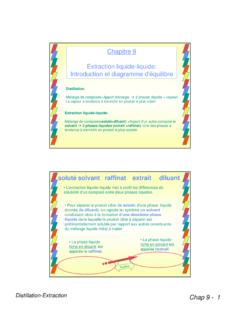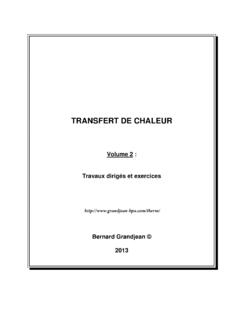Transcription of Flooding Capacity in Packed Towers: Database, Correlations ...
1 CORRELATIONSF looding Capacity in Packed Towers: Database, Correlations , andAnalysisSimon Piche , Fa 1c al Larachi,* and Bernard P. A. GrandjeanDepartment of Chemical Engineering and Center for Research on the Properties of Interfaces and Catalysis(CERPIC), Laval University, Que bec, Canada G1K 7P4 Experimental results on the Flooding Capacity of randomly dumped Packed beds were collectedfrom the literature to generate a working database. The reported measurements were first usedto review the accuracy of existing predictive tools in that field. A total of 14 Correlations wereextracted from the literature and cross-examined with the database. Many limitations regardingthe level of accuracy and generalization came to light with this investigation. Artificial neuralnetwork modeling was then proposed to improve the broadness and accuracy in predicting theflooding Capacity , which is an important design parameter for Packed towers.
2 A combination ofsix dimensionless groups, namely, the Lockhart-Martinelli parameter ( ); the liquid Reynolds(ReL), Galileo (GaL) and Stokes (StL) numbers; the packing sphericity ( ); and one bed number(SB) outlining the tower dimensions were used as the basis of the neural network an initial database containing 1019 measurements, the correlation yielded an absoluteaverage relative error (AARE) of and a standard deviation of Another databasecontaining over 100 measurements on the Flooding Capacity was used to validate the prediction based on these results yielded an AARE of and a standard deviation Through a sensitivity analysis, the Stokes number in the liquid phase was found to exhibitthe strongest influence on the prediction, while the liquid velocity, gas density, and packingshape factor were determined to be the leading physical properties defining the Flooding a matter of fact, the neural correlation remains in accordance with the design recommenda-tions and trends reported in the Historical OverviewPacked towers operated in a two-phase counter-current manner have maintained an important role intoday s chemical industry.
3 Introduced early in the 20thcentury, the general concept has constantly evolvedaround the progress of various packing shapes that arestated to increase the tower s efficiency as well as toreduce the operating costs. Currently, Packed towers areused for several purposes, especially in distillation,absorption, and stripping processes. Because the opera-tion of Packed towers is considered to be cheap, theyare of great interest for pollution control. However, theireffectiveness will suffer if the design considerations donot suit the operating conditions. To improve thatmatter, several Correlations , either empirical or semi-empirical, were developed to gain precision over the 1920s, many experiments have been carriedout to understand the consequences of various operatingparameters on the bed effectiveness. These studies canbe divided into two distinctive categories, those relatedto the mass transfer efficiency and those related to thehydrodynamic phenomena.
4 While the first topic impliesthe evaluation of volumetric mass transfer coefficients,the latter one regroups the studies of flow behavior,liquid hold-up, and pressure drop across the physical phenomenon emerges that must beinvestigated first, as its level of importance will inevi-tably influence every other parameter mentioned capacityconsists essentially in a determi-nation of the amount of fluid in the bed at which theliquid starts to overflow. Because the Flooding capacitycan only be observed and not measured, there is noaccurate definition to describe this phenomenon, and itcan be interpreted in many ways. For example, Silveyand Keller1enumerated over 10 definitions proposed bydifferent authors. From that list, two distinctive cat-egories can be outlined. The first includes methodsinvolving visual inspection of a column undergoingflooding. The second type, inferential in nature, that alsoproved to be effective relies on a graphical detection of slope inflation in pressure drop and liquid hold-updiagrams as a function of the gas flow rate.
5 Hence, theoperating point beyond which a tiny increase in gasvelocity produces a substantially large change in pres-sure drop and liquid hold-up in the column is the basicdefinition for since Packed beds were introduced, ongoingefforts have been made by engineers in an effort tounderstand the phenomenology of the Flooding capacityin Packed beds. A comprehensive summary of all* Corresponding author. Phone: 1-418-656-3566. Fax: 1-418-656-5993. E-mail: Eng. Chem. ,40, CCC: $ 2001 American Chemical SocietyPublished on Web 11/30/2000published Correlations on the Flooding Capacity is pre-sented in Table is not before 1935 that the first results on floodingcapacity in beds of Raschig rings were this undertaking, Sherwood et first known correlation on that subject. Using dataon the air-water system exclusively, a curve represent-ing the Flooding Capacity was drawn on a specific set ofaxis parameters.
6 Such an idea has helped to form theso-called generalized pressure drop correlation (GPDC)concept, introduced in the mid 1950s by a large experimental survey, several isobaric curveswere sketched on a set of axis parameters similar toSherwood s diagram in order to provide an accurate toolfor determining the pressure drop in Packed beds. Theupper line on the chart represented the Flooding capacityof the bed occurring at a pressure drop of around in. of water per foot of bed for packing elementsof the first generation like Raschig rings and Berlsaddles. Similar charts were developed to cope with theinconsistencies as it was considered the only reliablesource to determine the pressure drop and ,13,15,19-21 Later, new packing shapes appearedon the market, stated to reach better performance. Asan example of higher efficiency, the pall ring , a second-generation packing, could reach a pressure drop of of H2O/ft at flooding22which is lower than previousresults for less porous beds of first-generation , generalized pressure drop correlationswere limited to first-generation packings as the floodingcurve was implemented for pressure drops of H2O/ft.
7 It is only much later that Kister and Gill13introduced the idea of correlating the pressure drop atflooding in order to again make accessible the use ofGPDCs for predicting the Flooding Capacity in packedbeds containing an arbitrary second group of Correlations , emanating from theGerman school, focuses more on theoretical consider-ations of two-phase flow through Packed ,16 Inmost cases, these Correlations calculate the superficialgas velocity at Flooding for a given set of conditions. Adrawback inherent to these Correlations is that theyrequire empirical constants specific to the packing , these constants were notestablished for every packing element, which clearlyillustrates a lack of all aforementioned limitations, the presentwork aims at providing a new correlation in order toincrease the broadness and accuracy in predicting theflooding Capacity essential for design purposes of ran-domly dumped counter-current Packed columns.
8 Con-sequently, perceptron-like artificial neural network(ANN) modeling was employed here to identify theforces and packing parameters that are involved indescribing the Flooding phenomenon in terms of the mostappropriate set of Buckingham and other character-istic dimensionless groups. This model could thenbecome an ultimate tool for cases involving new packingshapes and/or different fluid packages showcasing sel-dom physical properties. A complete database contain-ing experimental results on the Flooding Capacity pub-lished in the literature since 1935 was first built andthen used to evaluate the strengths and weaknesses ofall important Correlations developed on that , a dimensionless ANN correlation is pre-sented, and its effectiveness discussed through statisti-cal comparisons against the most important empiricaland semiempirical Correlations from the literature(Table 1).
9 The methodology leading to the neuralnetwork correlation will not be detailed in this work asit has already been discussed ,242. Databases OverviewTwo databases containing 1019 and 101 sets ofexperimental results were used to develop the neuralnetwork correlation. They represent well the broadrange of packing shapes available on the market, fromthe common Raschig ring to high-throughput packingssuch as the IMTP ring22or the Jaeger ring ,25just toname a few. Similarly, a variety of operating conditionsis also exposed in the databases, spanning a broad rangefrom vacuum distillation to supercritical fluid condi-tions. While the first database, referred to as thecorrelationdatabase, was expressly used to build theANN correlation, the second and smaller one, thevalidationdatabase, served as a validation tool. Thispractice was established here to confirm the effective-ness of the correlation in predicting the Flooding capacityin specific cases such as prediction of Flooding forpacking shapes alien to the correlation databases together exhibit results on 27 packingtypes that were tested at least once for Flooding consid-erations (Table 2).
10 Unfortunately, most of the runs werecarried out between 1935 and 1950, when needs forglobal designing tools were being felt. In fact, near 75%of the correlation database contains results on what arecalled first-generation packings (Raschig rings, Berlsaddles, spheres, coke particles, and wire helices).Second-generation packings such as Pall and Hiflowrings constitute the remaining 25%. On the other hand,the validation database contains mostly results on third-generation packings that are more complex in shape andare not present in the correlation the same approach, several gas and liquidsystems were collected to assess the impact of physicalproperties such as the density, viscosity, and surfacetension. A total of 23 single, binary, and aqueous liquidsand 18 gas mixtures are tabulated in the 3 offers a more detailed description of the cor-relation database (1019 data sets) relative to the extentof the operating variables that are susceptible to havingan effect on the Flooding Capacity .







